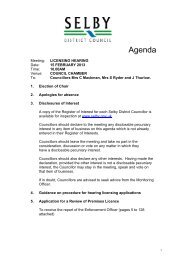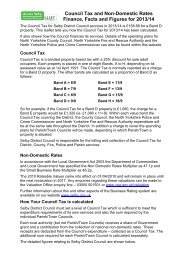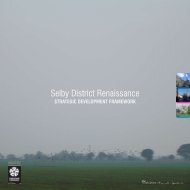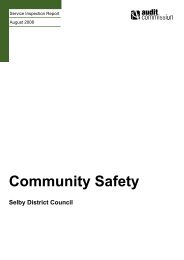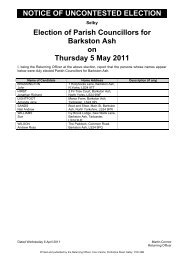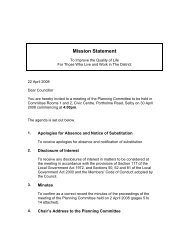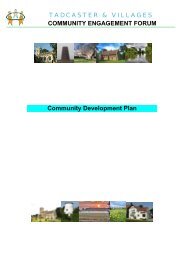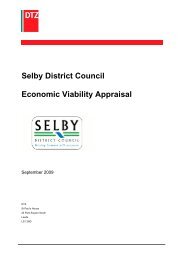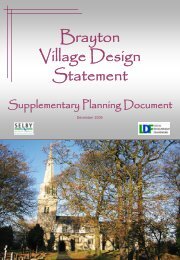Tracked Version of Core Strategy, November 2012 - Selby District ...
Tracked Version of Core Strategy, November 2012 - Selby District ...
Tracked Version of Core Strategy, November 2012 - Selby District ...
You also want an ePaper? Increase the reach of your titles
YUMPU automatically turns print PDFs into web optimized ePapers that Google loves.
<strong>Selby</strong> <strong>District</strong> Submission Draft <strong>Core</strong> <strong>Strategy</strong> – May 2011<br />
___________________________________________________________________<br />
Rural Diversification<br />
Introduction<br />
6.32 While most employment opportunities are concentrated in the<br />
three towns, the rural nature <strong>of</strong> <strong>Selby</strong> <strong>District</strong> also gives rise to a<br />
scattered distribution <strong>of</strong> settlements and associated employment<br />
opportunities. The quality <strong>of</strong> agricultural land within the <strong>District</strong><br />
supports an agricultural industry <strong>of</strong> national importance, which will<br />
continue to be supported. Nevertheless employment opportunities<br />
within agriculture and associated employment have declined over<br />
the years and are forecast to continue to decline. One objective <strong>of</strong><br />
the <strong>Strategy</strong> is to support rural regeneration by diversifying and<br />
strengthening the rural economy.<br />
6.33 Maintaining existing businesses and encouraging new businesses<br />
helps diversify rural employment opportunities, maintain the<br />
viability <strong>of</strong> smaller settlements and reduce the need for local<br />
people to travel longer distances to work. Policy CP10 outlines the<br />
principles for the location <strong>of</strong> new employment in rural areas, having<br />
regard to the sensitive nature <strong>of</strong> the local environment.<br />
Context<br />
6.34 Rural regeneration remains a strategic planning priority. PPS4<br />
(Planning for Sustainable Economic Growth), indicates that LDFs<br />
should:<br />
• Support diversification for business purposes that are<br />
consistent in their scale and environmental impact with their<br />
rural location while strictly controlling economic<br />
development in open countryside away from existing<br />
settlements.<br />
• Support the conversion and re-use <strong>of</strong> appropriately located<br />
and suitably constructed existing buildings in the<br />
countryside.<br />
• Seek to remedy any deficiencies in local shopping and other<br />
facilities to serve peoples day to day needs and help<br />
address social exclusion.<br />
• Where appropriate support equine enterprises providing for<br />
a range <strong>of</strong> suitably located recreational and leisure facilities<br />
and the needs <strong>of</strong> training and breeding businesses that<br />
maintain environmental quality and countryside character.<br />
• Support the provision and expansion <strong>of</strong> tourist and visitor<br />
facilities in appropriate locations where identified needs are<br />
not met by existing facilities in rural service centres balance<br />
against protecting landscapes and environmentally sensitive<br />
sites.<br />
- 91 -



